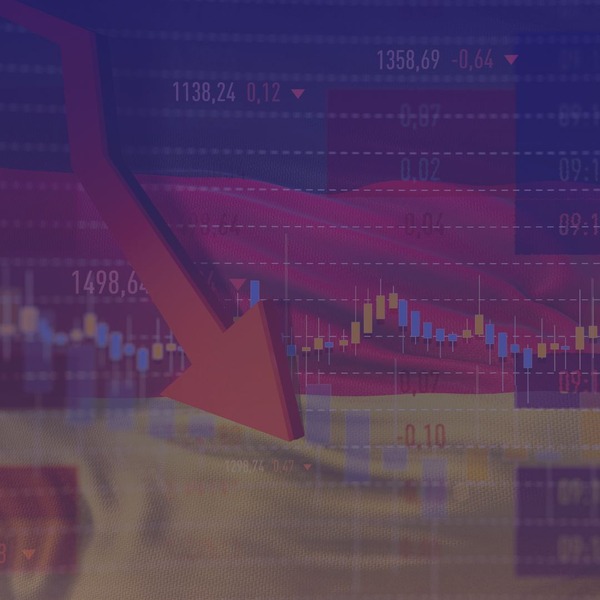
Written by: Jorge Ramos, EST Ambassador to Luxembourg
Edited by: Daniele Sorato
Following the United States and China, the European Union currently holds the position of the third-largest economy in the world in terms of GDP. However, when looking at productivity and economic growth indicators, the Union’s figures leave much to be desired, especially when compared to other global powers. Despite the acknowledgment of the issue by European policymakers, predictions by the European Central Bank (ECB) and the European Commission continue to forecast a stagnated expansion for the continent’s economy in the upcoming years (European Central Bank, 2024).
It is no secret that Germany is the most significant economic force within the EU, contributing the largest share of the overall European GDP. Yet, even the Federal Republic faces substantial difficulties. As revealed in the December 2024 Report of the German Central Bank, the decade of stagnation and the past two years’ pattern of recession are due to deeper structural challenges in the German Economic Model, intensified by the present shifts in both the national and international geopolitical landscapes (Deutsche Bundesbank, 2024).
Understanding the German Economic Model
Representing almost 1/3 of all EU value of sold industrial production in 2023 (Eurostat, 2024), the foundations of the Economic Model of Germany were based on an export-oriented economy focusing on high-quality, value-added manufacturing. Such industries account for almost 20% of the German GDP. The figures are reduced by nearly half in other economies like the US, France, or Spain. However, China poses a threat with its 30% of GDP industry, maintained through considerable governmental subsidies (Sobel and Pearce, 2024).
The model that has driven Germany to growth in the last decades was based on the purchase of Russian energy at a very affordable price (Barber & Quach, 2024). With reduced production costs, national firms were able to lower consumer prices. Therefore, German businesses possessed a comparative advantage in costs compared to foreign firms, allowing their goods to be more attractive to customers. In addition, within the model, Germany also benefited from the cheap imports of consumer goods from China, as well as the protection from the US under NATO (Van Rij & Schröder, 2024). The model proved successful overall, with continuous annual growth of real GDP from the 2008 financial crisis until the arrival of the COVID-19 pandemic (Deutsche Bundesbank, 2024).
External causes for the fall of the German Economic Model
As a response to the illegal war of aggression in Ukraine, the Council of the European Union decided to expand a series of economic sanctions and diplomatic measures against Russia in February 2022. Among other objectives, the Union targeted the Russian energy sector, which plays a pivotal role in the Federation’s economy, as approximately 20% of its GDP comes from the oil and gas industries (Yermakov, 2024). However, previous to the invasion, European dependence on Russian energy resources accounted for more than 40% of the overall imported natural gas (Gross and Stelzenmüller, 2024). Within the EU, Germany represented Russia’s largest customer, relying on Russia for over 50% of its natural gas supply (Pandey, 2023).
Even though the sanctions focused on Russian oil and coal, European countries have diversified their sources of natural gas, and on August 31st, 2022, Russia completely ceased the flow of natural gas to Germany through the Nord Stream 1 pipeline (Pandey, 2023). In response, Germany established its first liquified natural gas terminal, and as of January 2025, there are four active ones (Bundesnetzagentur, 2025). Currently, Germany imports natural gas mainly from Norway and its neighbours Belgium and the Netherlands (Bundesnetzagentur, 2024). Nonetheless, despite Germany’s efforts to counterbalance the lack of Russian energy resources, the era of cheap oil and gas imports, hence the German firms’ cost-competitive advantage, is now over.
However, Russia is not the only challenge to the German Economic Model. The rise of protectionism within emerging markets, particularly China, has made the trade relationship between these two countries difficult. Beijing’s subsidies to domestic vehicle production firms and the adoption of tariffs on foreign businesses challenge German industrial exporting capacity to its largest buyer of automobiles. At the same time, China has been flooding international markets with its home-produced goods. By 2023, the Chinese exports of electrical vehicles to Europe grew by 361% since 2021 (Goh, 2023). Their ability to produce at a lower cost than their German counterpart challenges the Federal Republic’s industrial competitiveness as well as its trade balance, as China’s protectionism prevents the German sector from expanding as much in their market. Furthermore, up until 2022, Germany relied on China as its largest importer of raw materials, with 66% of Germany’s imports of rare metals coming from China (Braw, 2024). Therefore, Germany finds itself in a complicated situation since the use of trade retaliatory measures against China could disrupt its own supply chain.
Internal causes for the fall of the German Economic Model
As indicated by the German Central Bank report, the consequences of the demographic shifts in the European population, with longer life expectancy and declining fertility rates, are also reciprocally connected to economic growth. For instance, the EU will enter a period of GDP expansion without net growth of the workforce for the first time in modern history (Draghi, 2024). As labour productivity levels have stagnated since 2010, predictions of reduced workforce supply in the EU obstruct the future economic expansion of Europe. In the case of Germany, its ageing population affects the labour market, as patterns of demand for the new population do not match the current productive capacity of German industries. For example, if the senior population tends to buy cars at lower rates than the rest of the population, the volume of vehicle production (i.e., Germany’s largest manufacturing industry) will be reduced to adjust to new demand levels. The same will occur with other industrial products that tend to be consumed more by the younger strata of the population. These shifts in productivity are common throughout the Union, as the demographic transition is a reality not only in Germany but also in neighbouring European countries, with declining demand for German manufacture as a result.
After the publication of former President of the ECB Mario Draghi’s 2024 Report on European Competitiveness, it is no surprise that strict regulation and excessive bureaucracy are some of the main impediments to entrepreneurial growth and productivity levels in Europe. Germany is no exception: as indicated by the German Central Bank report, the demanding regulatory requirements for enterprises increase production costs and throttle innovation. For instance, the Gasumlage, the Government’s tax imposed on natural gas consumption, increases the production costs of German firms, favouring the cost-competitive advantage of foreign businesses. For some enterprises, gas costs can make up to 90% of the total production costs (The Economist, 2025). But this is not only a matter of national regulation. Although ambitious and pushing enterprises to shift their incentives, the implementation of the current European Green Deal is the single policy area of EU regulation that has caused higher economic expenses than savings for the bloc’s firms (European Commission, 2022). Just 15 out of more than 70 laws from the Deal raised 2.3 billion in additional administrative costs for small and medium-sized enterprises (Hancock, 2024). With an economic structure in Germany of more than 99% of firms being SMEs (BMWK, 2020), an excess of aggressive bureaucratic procedures significantly obstructs expansion and growth (Deutsche Bundesbank, 2024).
What does the economic stagnation of Germany mean for Europe, and how should this affect EU Economic Policy?
Germany’s current lack of economic growth, with little expectation for change in the upcoming years (Bundesbank, 2024), carries profound consequences for both Germany and the EU. The lack of sustained economic growth snatches Europe’s financial security to impose and expand its role and value as a global actor. This is particularly the case in the context of the war in Ukraine, the potential addition of Eastern-flank nations to the Union, and the rise of populism. European institutions such as the ECB have been pressured to adjust their interest rate policy to stimulate growth as an attempt to respond to Germany’s stagnation (ECB, 2024). However, given the structural nature of Germany’s challenges, interest rate cuts are insufficient to achieve growth in the long run.
If one thing has been made clear from the first part of the Draghi report, it is that further regulation is not the solution. Whereas in the form of expanding government expenditure, protectionism policies, or partial nationalizations, these strategies would not contribute to solving the stagnation problem in the long run. For instance, Next Generation EU (i.e., the latest European Commission package for economic recovery) proved that although financial stimulus packages do help increase overall growth, the results are not in line with expectations. In the case of Germany, it failed to produce a significant fiscal multiplier effect, seeing little benefit from the stimulus (Creel & Kaiser, 2024). Instead, European policymakers should revise grand projects like the European Green Deal, the Supply Chain Guidelines, or the General Data Protection Regulation (GDPR) to reduce the bureaucratic charge and economic costs they pose for firms in the context of already struggling competitiveness (Von Liechtenstein, 2024). By complying with the GDPR alone, European tech companies see their profits being reduced by 12% (Draghi, 2025). If Europe wants to become a notable global actor in innovation and prevent its tech companies from fleeing abroad, it will have to reduce the fiscal and bureaucratic burden on them, designing better tax incentives for young firms and reducing regulation for firms to expand.
Within the Single Market, policymakers should further facilitate trade within EU Member States. The rising use of protectionism policies by foreign nations should encourage European countries to foster commerce with each other. Compared to the US, European nations trade half as much as US states (Draghi, 2025). The remaining barriers within the European Single Market account for tariffs of 45% in the manufacturing sector and 110% for services (Draghi, 2025). Deepening the trade relations within the European Market would not only improve economic cohesion across borders, but also increase labour productivity by almost 7% (IMF, 2024).
Furthermore, Europe should seek energy diversification and learn the lesson of the dangers of excessive energy dependence. For decades, Germany has pursued an antinuclear policy approach, closing its last three remaining nuclear plants in 2023. However, after the metamorphosis of the national energy model, 67% of Germans now support nuclear energy for electricity generation, with 42% in favour of constructing a new nuclear power plant (Radiant Energy Group, 2024). Therefore, instead of relying on imports of energy that increase costs and reduce firm competitiveness, Germany should reconsider nuclear use, as it is technically and economically feasible (Radiant Energy Group, 2024). This cost-effective solution would stabilize Germany’s energy security in the context of rising energy demand, not only from traditional manufacturing industries but also from the rising AI sector.
Conclusion
Germany’s economic stagnation and late recession figures pose a significant challenge not only to the Federal Republic itself but to the EU as a whole. Externally, the loss of the cheap Russian energy supply after the invasion of Ukraine and the rise of Chinese protectionism pose a challenge to Germany’s industrial cost advantage and competitiveness in the international trade scene. Internal issues such as the demographic shift, the decline in workforce supply, and the excess of regulatory practices have further challenged the long-term expansion of German firms as well as its economic growth. Therefore, rather than addressing these issues with short-term fiscal policies to foster aggregate demand, German and European policymakers should cut bureaucratic barriers, deepen trade within the Single Market, and ensure the Federal Republic’s energy security. The lack of decisive and immediate structural reforms puts Europe and Germany at risk of further stagnation, with little global influence in an increasingly competitive geopolitical landscape.
Bibliography
Barber, T., & Quach, G. (2024) France and Germany: clouds darken at the dawn of a new EU era. Financial Times. Retrieved from: https://www.ft.com/content/239d88fa-e16e-4eac-8602-6c91f0930f43
BMWK – Federal Ministry for Economic Affairs and Climate Action. (2020). The German Mittelstand as a model for success. Retrieved from: https://www.bmwk.de/Redaktion/EN/Dossier/sme-policy.html
Braw, E. (2024) Germany Is Hardening Its Supply Chains Against Chinese Control. Foreign Policy. Retrieved from: https://foreignpolicy.com/2024/10/10/germany-china-supply-chains-de-risking-globalization/#:~:text=Like%20most%20modern%20economies%2C%20Germany,Germany’s%20Federal%20Statistical%20Office%20reported.
Bundesnetzagentur. (2024) Bundesnetzagentur publishes gas supply figures for 2023. Retrived from: https://www.bundesnetzagentur.de/SharedDocs/Pressemitteilungen/EN/2024/20240104_Gasversorgung2023.html
Bundesnetzagentur. (2025) Bundesnetzagentur publishes gas supply figures for 2024. Retrieved from: https://www.bundesnetzagentur.de/SharedDocs/Pressemitteilungen/EN/2025/20250108_GAS.html#:~:text=Germany%20consumed%20a%20total%20of,the%20years%202018%20to%202021.
Creel, J., & Kaiser, J. (2024) The Real Effects of Next Generation EU. Policy Study May 2024. The Foundation For European Progressive Studies. Retrieved from: https://feps-europe.eu/publication/the-real-effects-of-next-generation-eu/
Deutsche Bundesbank (2024) Monthly Report December 2024. Retrieved from: https://publikationen.bundesbank.de/publikationen-en/reports-studies/monthly-reports/monthly-report-december-2024-947276?article=forecast-for-germany-significantly-gloomier-growth-outlook-inflation-decreases-to-2–947278
Draghi, M. (2025) Forget the US — Europe has successfully put tariffs on itself. Financial Times. Retrieved from: https://www.ft.com/content/13a830ce-071a-477f-864c-e499ce9e6065
Draghi, M. (2024) The Draghi report: A competitiveness strategy for Europe. Retrieved from: https://commission.europa.eu/topics/eu-competitiveness/draghi-report_en#paragraph_47059
European Central Bank (2024) Eurosystem staff macroeconomic projections, December 2024. Retrieved from: https://www.ecb.europa.eu/pub/pdf/other/ecb.projections202412_eurosystemstaff~71a06224a5.en.pdf
European Commission. (2022) The European Union’s action to simplify legislation. Annual Burden Survey 2022. Retrieved from: https://commission.europa.eu/system/files/2023-09/ABS_20230912_0.pdf
Eurostat. (2024) Industrial production statistics July 2024. Retrieved from: https://ec.europa.eu/eurostat/statistics-explained/index.php?title=Industrial_production_statistics
Gross, S., & Stelzenmüller, C. (2024) Europe’s messy Russian gas divorce. Brookings. Retrieved from: https://www.brookings.edu/articles/europes-messy-russian-gas-divorce/#:~:text=Before%20the%20invasion%2C%20more%20than,supply%2C%20including%20Austria%20and%20Latvia.
Goh, B. (2023) Explainer: What is driving Chinese EV exports and their price competitiveness? Reuters. Retrived from: https://www.reuters.com/business/autos-transportation/what-is-driving-chinese-ev-exports-their-price-competitiveness-2023-09-14/#:~:text=That%20is%20mainly%20due%20to,models%2C%20the%20European%20Commission%20says.
Hancock, A. (2024) Is red tape strangling Europe’s growth? Financial Times. Retrieved from: https://www.ft.com/content/4e8e6cde-d0ce-4f0a-a7ea-1c913d4dad50
International Monetary Fund. (2024) Regional Economic Outlook Notes: Europe. Europe’s Declining Productivity Growth: Diagnoses and Remedies. November 2024
Pandey, A. (2023). EU gas supply: When Russia went into self-destruct mode. DW News. Retrieved from: https://www.dw.com/en/eu-gas-russia-nord-stream-crisis/a-66668256
Pitel, L. (2023) Germany torn over energy policy as nuclear plants shut down. Financial Times. Retrieved from: https://www.ft.com/content/24247417-2a69-47ab-bab3-b81befad8335
Radiant Energy Group. (2024). Restarting Germany’s Reactors: Feasibility and Schedule. Retrieved from: https://www.radiantenergygroup.com/reports/restarting-germanys-reactors-feasibility-and-schedule
Sobel, M., & Pearce, T. (2024). Germany’s growth model is broken. OMFIF. Retrieved from: https://www.omfif.org/2024/09/germanys-growth-model-is-broken
The Economist. (2025) German business is being suffocated by high costs and red tape. The Economist. Retrieved from: https://www.economist.com/business/2025/02/09/german-business-is-being-suffocated-by-high-costs-and-red-tape
Van Rij, A., & Schröder, P. (2024). The break-up of Scholz’s coalition government signals the end of Germany’s old economic model. Chatham House. Retrieved from: https://www.chathamhouse.org/2024/11/break-scholzs-coalition-government-signals-end-germanys-old-economic-model
Von Liechtenstein, M (2024) The disastrous consequences of the new EU supply chain guidelines. Geopolitical Intelligence Services (GIS). Retrieved from: https://www.gisreportsonline.com/r/eu-supply-chain-directive
Yermakov, V. (2024) Follow the Money: Understanding Russia’s oil and gas revenues. The Oxford Institute for Energy Studies. Retrieved from: https://www.oxfordenergy.org/wpcms/wp-content/uploads/2024/03/Follow-the-Money-Russian-Oil.pdf

 The ’Ndrangheta’s Infiltration and Threat to European Institutions
The ’Ndrangheta’s Infiltration and Threat to European Institutions  From Paper to Practice: How Grassroots Norms Undermine Gender Rights in Pakistan
From Paper to Practice: How Grassroots Norms Undermine Gender Rights in Pakistan  Exploited Childhoods: The Role of Global Corporations in Perpetuating and Mitigating Child Labour
Exploited Childhoods: The Role of Global Corporations in Perpetuating and Mitigating Child Labour  Human Rights Challenges in Addressing SLAPPs in Media, NGOs and Journalism in the EU
Human Rights Challenges in Addressing SLAPPs in Media, NGOs and Journalism in the EU 


